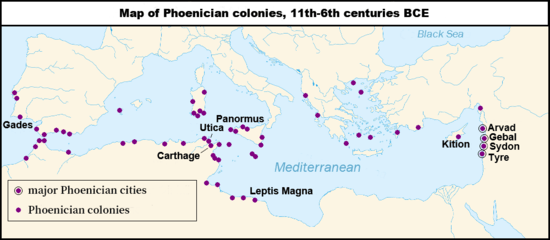Macomades
Macomades was a Carthaginian and Roman city in North Africa. It was located near present-day Oum-El-Bouaghi, Algeria
History
Macomades was established as an inland Punic trading post under the name MQMʾ (Punic: 𐤌𐤒𐤌𐤀,[1] "Place"). It was about 64 kilometers (40 mi) from Cirta.[1] It issued its own bronze coins with an Egyptian-style god's head obverse and a reverse bearing either a hog and galloping horse or a disk in a crescent, a symbol of the Punic goddess Tanit.[1]
It was a town in the Roman province of Numidia.
It was overrun by the Umayyad Caliphate during the 7th-century Muslim invasion.
Religion
No later than AD 256, the town was the seat of a Christian bishop. The diocese was in abeyance after the Muslim conquest of the region until it was restored by the Roman Catholic Church in 1933 as a titular bishopric (diocesis Macomadensis).[2]
List of bishops
- Cassius, at the council of Carthage called in 256 by Saint Cyprianus to discuss the 'lapsed' Christians who preferred forced idolatry to martyrdom
- Donatus, mentioned after 406, praised by Saint Augustine of Hippo in Contra Cresconium for abjuring the heresy Donatism
- Aurelius participated in the 411 council of Carthage (where both Catholic and heretical bishops were invited) as well as his Donatist counterpart from Macomades, Sallustius
- Pardalius was exiled after participating in the 484 synod of Carthage, called by the Vandal king Huneric, an Arian; in 487 he parttook, probably as Numidian delegate, in Pope Felix III's Lateran Council.
- Florentino Armas Lerena (8 April 1967 – 25 November 1979), while first Bishop-Prelate of Territorial Prelature of Chota and still on emeritate
- Ricardo Watty Urquidi (27 May 1980 – 6 November 1989), as Auxiliary Bishop of Mexico City, later Bishop of Nuevo Laredo, Bishop of Tepic
- Francisco Clavel Gil (from 27 June 2001), emeritus as former Auxiliary Bishop emeritus of Mexico City
See also
References
Citations
- Head & al. (1911), p. 886.
- 1.
Bibliography
- Head, Barclay; et al. (1911), "Numidia", Historia Numorum (2nd ed.), Oxford: Clarendon Press, pp. 884–887.
- Huss, Werner (1990), Der Karthager, Munich: C.H. Beck.
